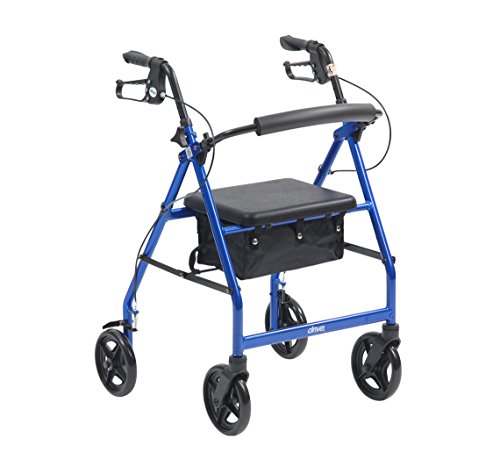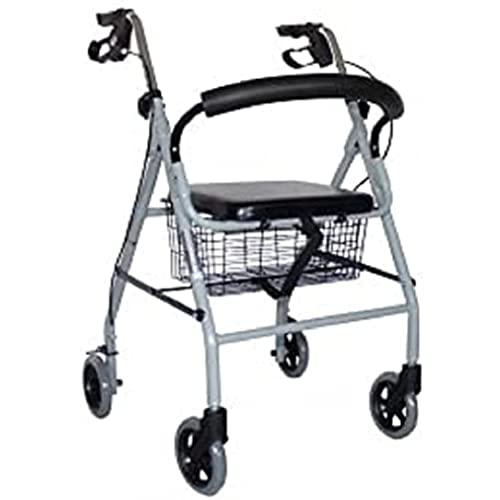See What Rollator Mobility Walker Tricks The Celebs Are Using
페이지 정보

본문
 Rollator Mobility Walker
Rollator Mobility Walkerrollators walkers are an excellent option for those with limitations in mobility and require stability while walking. They come with large wheels and space for seats built into their frames.
This model features padding on the handles to offer comfort and relieve hand pressure. It has height-adjustable handles and intuitive loop locks to prevent the walker from moving while you are sitting or resting.
Comfort
Whether someone has recently suffered an injury that impacts their gait and balance, or is recovering from knee, hip or other lower-limb surgeries or injuries, a rollator mobility walker can aid. These walking aids provide stability and support, allowing users to move more comfortably and stay active with family and friends as well as the community.
These devices are available in various styles, including a conventional walker with no wheels and appears more plain than the rollator. Walkers typically have handles that are placed at a height that is comfortable replacement bag for rollator walker the user, which makes them suitable for people who requires stability but still is able to move more easily than a cane.
However, the wheels on a lightest rollator make it more flexible than a regular walker, and easier to use. The wheels on a rollator are closer to each other, making it easier to move and guide the device in tight spots. They can also be rotated to improve agility when going up and down the stairs. A lot of rollators have a seating area with a crossbar to ensure users can sit down when needed.
Handles for rollators are constructed from materials that vary in texture and thickness. Look for handles that have soft texture and a soft plastic grip. This is easier to hold for people with arthritis. Also, think about whether the model you pick has loop-lock brakes or lean-activated breaks that can accommodate the various hand strength levels.
Stability
A good rollator walker must include a comfortable and wide seat that users can sit on when they require to take a break from walking. It should have easy-to-operate brakes and ergonomic, soft grips. The grips should be cushioned and comfortable for people with hand or wrist issues. Some models come with backrests that are padded. You should choose the walker that has a weight capacity that is sufficient for your needs and adjustable handles to accommodate your height.
A walker with a locking mechanism is essential for those who frequently travel or need to transport their walker inside and out of vehicles. This will help prevent the walker from being opened accidentally during transport to avoid injury and damage. Think about whether the walker is customizable to your needs by having removable and interchangeable components.
In a recent study, researchers examined how task-performance strategy and device load affect the the stability of users of rollators. Ten participants completed six tasks using a rolling cane that was instrumented. The team measured system Stability Margin, which is the sum of centre pressure and base support. The team discovered that SM decreased significantly when a person was asked to do other tasks than straight line walking. They also found out that leaning on the device can increase the force centre in the support base and increase or decrease stability. The authors conclude that the results can be utilized to improve the rollator training. They suggest that a greater focus should be given to activities other than straight line walking and on the specific strategies used to achieve the goals of each activity that can aid or hinder stability.
Capacity for weight-bearing
A rollator walker can support up to 300 pounds or more, based on the model. Its sturdy frame and four wheels aid people in maintaining their mobility and balance, especially for individuals with medical conditions or who are aging. Rollators are more maneuverable than standard walkers that require users to lift their weight in order to move forward. This helps reduce hand fatigue.
Rollators have wheels that are usually 6 to 10 inches wide. This allows them to be used indoors and outdoors on various surfaces. Certain models have a variety of height settings to accommodate different users. Others fold to make it easy to transport and store. Some even feature a seat for users to rest while walking.
Many walkers come with a range of accessories, such as a walker basket that can hold personal items, or a tray to place food on while using the device. A wrist guard is offered to protect your hands from injury and bags for walker's to carry other items. Some walker frames can be converted to wheelchairs when the mobility requirements of an individual change.
A bariatric rollerator is designed to accommodate larger individuals safely. It has a heavy-duty frame and a seat that is wider. It features height-adjustable handles and a wide padded backrest as well as hand brakes that are locked to ensure the maximum security and safety. The angled handle bars position the hands in a neutral position to reduce fatigue and stress and its handy storage strap allows it to be easily tucked into a trunk. The durable 8" wheels come with anti-tip technology that provides added stability and maneuverability, and the seat is padded to provide an ideal place to rest while you travel.
Brakes
A rollator is distinct from a traditional walker. Instead of having all four legs touching the ground, a buy rollator walker comes with wheels that are independently controlled by hand brakes that are located below or embedded into the handlebars. This design helps to make it easier for users to navigate tight spaces and make precise left and right turns. The brakes could become difficult to operate or loose, which could be a risk to those with limited strength and declining mobility.
To avoid these issues, many manufacturers offer the option to add brakes that can be locked to provide stability and safety. This feature is especially useful for those who have difficulty pressing the brakes or applying pressure due to a weak grasp or other health issues such as arthritis. There are a few differences in the method that locking brakes are set up, but most walkers use similar methods to ensure that they are correctly adjusted.
It is crucial to follow the maintenance instructions included with your mobility device to get specific instructions prior to attempting to adjust the lock brakes. To begin, locate the brake adjustment screw or knob, which is typically close to the grips of the handle. Make sure to tighten it by rotating clockwise. This is crucial because if the adjuster isn't properly tightened, it will not be able to pull slack from the brake cable. After you have tightened the screw for adjustment of the brake, move on to the lower cable adjuster nut and tighten it using the same procedure. After you have completed these adjustments test the brakes by pressing them gently to see whether they respond correctly. If they do not then the locking mechanism is probably not working properly.
Accessories
There are a variety of accessories available for walkers with rollators, such as cups and baskets. Certain accessories are designed to carry objects while walking, and others, such as the Mobility Phone Grip clip onto the bars that are vertical on the walker or wheelchair, and expand to hold the smartphone. The grips can also swivel and adjust to the best height for holding the device. A lot of these devices are designed to be light and easy to use, which makes them perfect for those suffering from hand injuries or arthritis.
Most walker and rolling walker manufacturers offer different handle heights so you can select the one that's suitable for your body type. Be aware of the weight capacity when choosing the right rollator. This will affect the way it performs for you. While most models are designed to accommodate individuals who weigh up to 300 pounds, some manufacturers provide models that can accommodate up to 500 pounds.
Another thing to think about when choosing a walker rollator is the type of brakes it uses. Push down brakes stop forward movement by applying downward pressure to the frame. Loop brakes work similarly but require both hands to be utilized and a little more strength. Both kinds of brakes are a vital safety feature, so it's crucial to choose the best rollator walker for tall person option for your needs.
If you're not sure which type of walker or rollator is the right one for you, it's recommended you consult with a physical therapist, doctor or occupational therapist. They will be able to advise you on the features that would be most beneficial to your particular situation, and help you find a model that's compatible with any equipment you may have at home or in storage.

- 이전글The Tried and True Method for Chatgpt 4 In Step-by-step Detail 25.01.22
- 다음글Prothèse Auditive à Vendre : Ce que Vous Devez Savoir 25.01.22
댓글목록
등록된 댓글이 없습니다.




